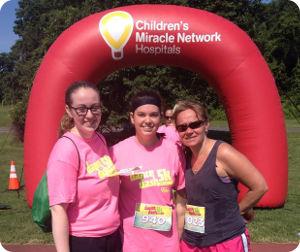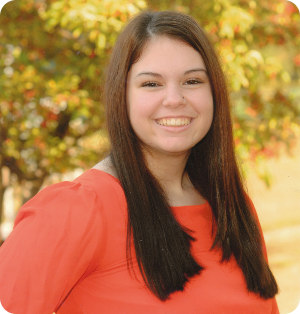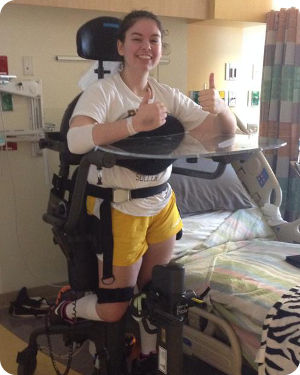“Without this hospital, I wouldn’t get my life back. They’re making it possible for me to go to college, to have a family.”

Kelsey Conquers a Crippling Pain Condition
When high school senior Kelsey Goodwin of Delran, N.J. sprained her foot playing soccer, an orthopedist put her leg into a boot, predicting a 30-day recovery. But when the boot came off, showing a mottled purple leg too painful to be touched, a neurologist diagnosed reflex neurovascular dystrophy or RND.
RND develops when an injury doesn’t heal properly and the nervous system malfunctions – its signals going haywire. The result is prolonged and excessive pain, with diminished strength and function.
 Despite nerve blocks and outpatient physical therapy, the burning pain spread up Kelsey’s entire right side. And it kept getting worse. “It was frustrating,” says the normally cheerful teen, who has been class president for six years. “I couldn’t keep up with friends or go out. If the wind brushed by me, it caused excruciating pain. I was absent a lot from school.”
Despite nerve blocks and outpatient physical therapy, the burning pain spread up Kelsey’s entire right side. And it kept getting worse. “It was frustrating,” says the normally cheerful teen, who has been class president for six years. “I couldn’t keep up with friends or go out. If the wind brushed by me, it caused excruciating pain. I was absent a lot from school.”
Then the Goodwin family found PSE&G Children’s Specialized Hospital. The New Brunswick facility offers the state’s only inpatient pediatric chronic pain rehabilitation program. In response to the uptick in kids who need its state-of-the-art pain services, Children’s Specialized Hospital has raised nearly $1.5 million to expand the New Brunswick site by eight beds, which will let the hospital treat more children in its chronic pain program. The amount represents half the funds needed.
Lucky for Kelsey, our pain program is a leader in the diagnosis and treatment of RND. Hard to diagnose, the condition is sometimes misdiagnosed or dismissed as psychosomatic. Children and adolescents who come here have been through a lot,” says Dr. Katherine Bentley, the physiatrist – the non-surgical specialty treating mobility conditions through rehabilitation – who heads Kelsey’s treatment team. “Many of our patients have had other treatments that haven’t worked. We are often their last hope.”
PSE&G Children’s Specialized Hospital’s gold-standard treatment for RND includes long, grueling hours of various physical therapies, and psychological therapy. Patients benefit from the advanced ZeroG machine, which promotes walking by reducing a patient’s weight. Kelsey’s regimen involved two hours daily of physical therapy, three hours of occupational therapy, and one hour in the pool. In nine weeks, she recovered fully. Kelsey burst back into her life, running two to three miles a day, pain-free.
A couple of months after Kelsey was discharged home, she tore a ligament in her right thumb. A week before the cast came off, she felt the old burning. The RND was back. By January of 2014, the pain was everywhere. Now in a wheelchair, Kelsey stopped going to school. In late March, Kelsey was back with Dr. Bentley at PSE&G Children’s Specialized Hospital.
 While studies show there is a 31 to 50 percent incidence of recurrence of RND among children and adolescents after the initial bout, the physiatrist is optimistic. “Kelsey is a very motivated, hard-working young woman. I’m confident our program will help again.” Recently, Kelsey took her first steps, partially supported by the ZeroG machine – a breakthrough she eagerly posted on Facebook. Says Kelsey’s dad, Jim, of the program, “If you see the problems these kids go in with and the unbelievable transformations that happen here, you know the program is invaluable. You can’t put a price on it.”
While studies show there is a 31 to 50 percent incidence of recurrence of RND among children and adolescents after the initial bout, the physiatrist is optimistic. “Kelsey is a very motivated, hard-working young woman. I’m confident our program will help again.” Recently, Kelsey took her first steps, partially supported by the ZeroG machine – a breakthrough she eagerly posted on Facebook. Says Kelsey’s dad, Jim, of the program, “If you see the problems these kids go in with and the unbelievable transformations that happen here, you know the program is invaluable. You can’t put a price on it.”
Kelsey puts it this way: “Without this hospital, I wouldn’t get my life back. They’re making it possible for me to go to college, to have a family.” Her care here has inspired Kelsey’s new career choice. “Because of this experience, I want to be a pediatric physical therapist. I want to do what they’ve done for me, for other kids.”